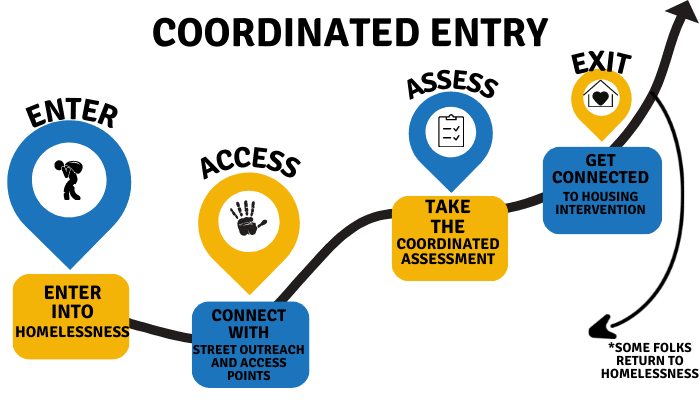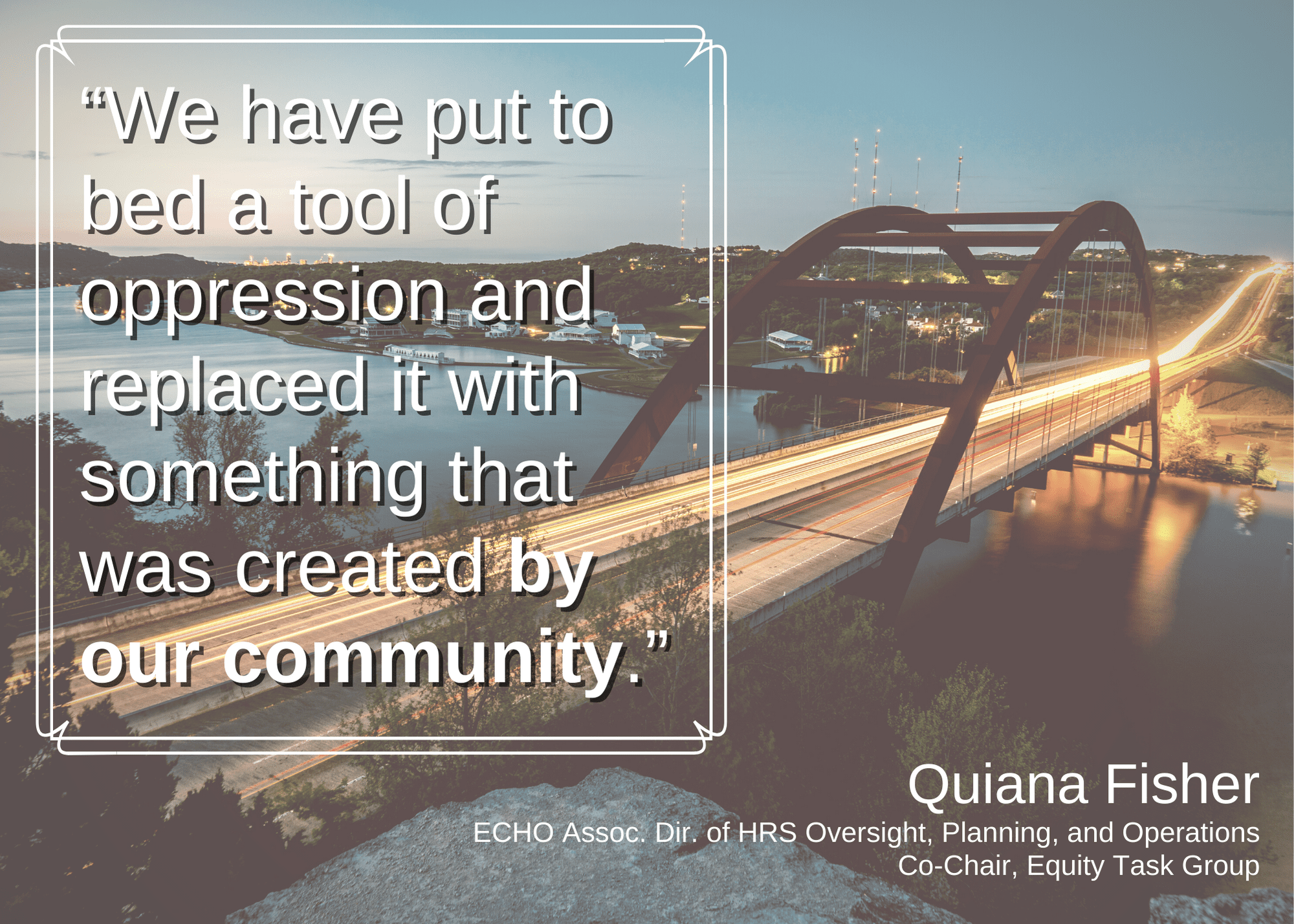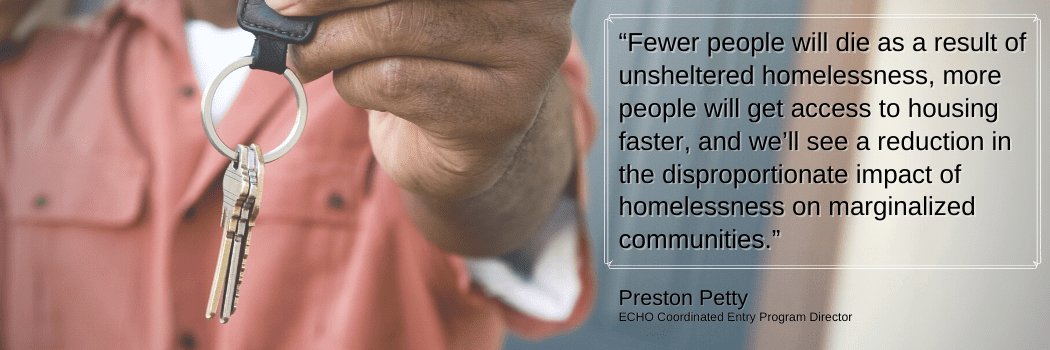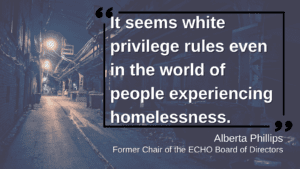Austin Prioritization Index
Watch a presentation and discussion about the Austin Prioritization Index and its impact on equity in our community’s Homelessness Response System on our YouTube channel or our Facebook page.
Creating a New Map towards Equity and Abundance
Historically, challenges and barriers have been created in how we face ending homelessness in an equitable way. The Austin Prioritization Index (API), developed specifically with racial and gender identity equity lenses, is the culmination of nearly two years of work by the Equity Task Group and members of the Homelessness Response System (HRS) Leadership Council. The API is a series of questions used during the Coordinated Entry process to determine the kind of housing intervention a person needs, prioritizing those who are most vulnerable to the risk of death while experiencing homelessness.
And that’s the crux of this work. People are dying on the streets. We live in a world of abundance with mindsets of scarcity that lead to further marginalizing those already most vulnerable. Read on to learn more about the work to customize our prioritization tool to the specific needs of our city. Ending homelessness does not have a “one size fits all” solution. The API is but a step in this journey to see a community that embraces all of its citizens in all of the abundance we take so for granted every day.
Rhie Azzam Morris, Austin HRS Leadership Council Member
Federal Technical Assistant in Homelessness
Who you'll be hearing from
This Q&A pulls from the experience and expertise of some of the people involved in creating the API. You will see quotes from them throughout the page. This section can be used as a reference to learn more about who you’re hearing from.
Rhie Azzam Morris | Member of Leadership Council, the Continuum of Care’s governing body; federal Technical Assistant in homelessness; core member and former co-chair of the Equity Task Group that created the API; advocate with lived expertise of homelessness in Austin; co-author of this Q&A
Quiana Fisher | ECHO’s Associate Director of Homelessness Response System Oversight, Planning and Operations; co-chair of the Equity Task Group
Summer Wright | Member of Leadership Council; core member of the Equity Task Group; member of the Austin Youth Collective; advocate with lived expertise of homelessness in Austin
Claire Burrus | ECHO Research and Evaluation Analyst; core member and staff support for the Equity Task Group
Preston Petty | ECHO Coordinated Entry Program Director; core member and staff support for the Equity Task Group
What is the API?
The Austin Prioritization Index (API) is a new equity-centered prioritization tool all community assessors in Austin/Travis County will use for Coordinated Assessments starting October 1. Some of the questions will be familiar to people who have experience with the prior prioritization tool, but many are new. Throughout this page you will find examples of the changes the API brings and explanations for why the team who assembled the tool made these changes.

If none of this sounds familiar, this first section is a good place to start.
Seasoned assessors may want to skip to the next section.
-
What is a prioritization tool?
Prioritization tools like the API exist because there simply is not enough housing in our – or almost any – community to connect everyone who needs it to the housing intervention that will best support them in their journey back to stability. These tools were developed as part of the Coordinated Entry process to assess the level of support a person may need to regain housing stability and to prioritize the most vulnerable people who are at the greatest risk of harm, death, or medical complications if they were to continue living unsheltered in the community.
-
How does a prioritization tool work?
Community assessors ask people experiencing homelessness a series of yes-or-no questions intended to determine a number of factors that influence a person’s risk level. These factors include:
-
- The likelihood a person can self-resolve their current episode of homelessness
- Chronic or serious medical challenges that may worsen due to living outside
- Other risks, such as pregnancy, having minor children, or advanced age
- The range of services and supports a person is likely to need to remain stably housed and not return to homelessness
Equally important is the need to address the racial and gender inequities that exist in the unsheltered population in our community. Black, Brown, and transgender people face institutional barriers to stability, like discriminatory housing policies and police violence, that can prevent people in these groups from self-resolving their homelessness and remaining stably housed. “Vulnerability” is not only the risk of immediate death on the street but an inability to self-resolve an episode of homelessness because without support from the response system, the only alternatives to self-resolution are institutionalization or death. A prioritization score that is truly reflective of risk and need takes into account these factors as well.
Each ‘yes’ answer to the series of questions on the assessment counts as a point, and the resulting total from the assessment provides a prioritization score. When a housing opportunity becomes available, direct service providers are able to connect people with corresponding prioritization scores to those resources. A higher score typically means a person is connected to a longer-term intervention such as Permanent Supportive Housing (PSH), while a lower score is more likely to result in a connection to a shorter-term intervention that is still able to meet a person’s true need.
-
-
Why not use a first-come, first-served approach to housing?
Until the development of Coordinated Entry systems, providers used their own individual waitlists, many of which were first come-first served. This type of system advantages people who are not disabled, have consistent access to technology, like phones and the internet, and don’t face systemic barriers due to race or gender.
In a system with limited resources, not everyone who needs services will be able to receive them, at least not quickly. A first come-first served system does not distribute these limited resources in an equitable, effective way. Prioritization tools like the API allow communities to work toward the most equitable distribution of resources possible and connect people who are most in need to housing as quickly as possible.
What does the API replace?
The API is a replacement for the Vulnerability Index – Service Prioritization Decision Assistance Tool (VI-SPDAT), a prioritization tool used in Austin since our community first implemented Coordinated Entry several years ago.
It’s not a total replacement. In addition to the adopted questions and a few additional pilot questions that our community developed with an explicit focus on equity, the API includes several questions from the VI-SPDAT that our analysis show increase equity for transgender and/or nonbinary/gender non-conforming people experiencing homelessness.

-
What is the VI-SPDAT?
The VI-SPDAT (Vulnerability Index-Service Prioritization Decision Assistance Tool) was developed by the national consulting firms OrgCode and Community Solutions as a triage tool for coordinated entry. Ostensibly, this is a tool that is intended to allow front line staff at provider agencies to identify and prioritize those most vulnerable to death on the streets in a standardized and efficient manner. The VI-SPDAT has been popular amongst CoCs nation-wide for its compliance with HUD and some version is currently used by more than 70 communities across the country. It has emerged as a leading tool nationally since 2014.
The VI-SPDAT is an assessment tool that uses “yes/no” questions to determine the vulnerability and need of the client and then prioritizes them based on the outcome on a scale of 0-17. Folks answer questions about risk factors including medical conditions, mental health, substance use, and length of time homeless. Based on the score received, the client will be recommended and placed into various housing interventions ranging from diversion and prevention, to permanent supportive housing.
-
Why did Austin/Travis County need to replace the VI-SPDAT?
Inevitably issues will arise when there is an attempt to standardize work that is centered in the wholeness of humanity. One of the largest, if not the most critical, that has arisen with the VI-SPDAT has been racism. In October of 2019, C4 Innovations released findings in their Coordinated Entry Systems Racial Equity Analysis of Assessment Data report that demonstrated this flaw with our standardized tool. The study shows that white people are more likely to answer “yes” to the questions posed by the VI-SPDAT than any other racial group. There are many factors to consider in why this is true, from the questions themselves, to the training and representation (or lack thereof) of the assessors, to where the access points are located geographically within the community. Not to mention the potentially (and from this author’s personal experience, definitively) re-traumatizing questions.
Also, it is nearly impossible to use standardized questions for every community. Communities are unique, with their own diverse makeup of demographics, wealth, accessibility, cultures, resources; all of these are particular to your city/town/neighborhood and thus population. When we look at our Coordinated Entry, we have to identify the gaps that are exclusive to our community’s data in order to meet the needs of our population. And that is what we did.
-
What does the API borrow from the VI-SPDAT?
The questions from the VI-SPDAT that are included in the API are those which our analysis shows are more likely to prioritize transgender people expriencing homelessness, a marginalized group that faces particular challenges living unsheltered and requires specific focus.
While the VI-SPDAT set a standard for identifying people who benefit most from access to housing, it’s an imperfect tool that was not created specifically to advance racial and gender equity. The original questions carried over into the API may incidentally promote gender equity, but that was not the goal.
-
So what’s different about the API?
The biggest change that the API represents is one of customization. The API is a tool created based specifically on the needs of our community with the first focus being in equity. Many communities rely on the VI-SPDAT or similar “off the shelf” tools that have been standardized as a “one size fits all” response. We know that one size fits all simply doesn’t work. The API was created for the needs and with data of the Austin community. By researching our own disparities and identifying the points of vulnerability that contribute to and detract from our equity goals, we have been able to approve a “living” prioritization tool customized to our community’s needs.
We studied the outcomes from VI-SPDAT and have incorporated some of the questions once we identified that those questions were neutral or added to our equity goals. Most importantly, our team that worked to develop, test, and assess all questions–those we continue to use from VI-SPDAT and those we developed “in house”–was comprised of Black and Brown people, folks with lived experience of homelessness, and members of our LGBTQIA+ community. This is a major difference in the process development of recommendations and changes to policies from the traditional way of doing things. (Learn more about the process to develop and test questions in the section titled “How did the API come about?”)
We know that those who don’t know what to ask, ask the wrong questions and then create policies, procedures, and tools (perhaps such as prioritization tools) based on wrong information. In Austin, we were intentional in engaging a wide array of voices in this process in a meaningful way. It’s so easy to tokenize people, to “check the box” of diversity and inclusion without meaningfully allowing people who are most impacted to lead and be involved. What makes API different is that it is a living example of what it looks like for people with lived experience to not just “have a seat at the table” but what it looks like to create the table itself.
By having folks with lived experience and expertise, we were able to honor and recognize that the questions that come along with prioritization assessments are often retraumatizing, and so adapt accordingly with the wholeness of those experiencing homelessness at the forefront of our work. The API is a major step forward, but we know it’s just a first step. Our community must also address the development and evolution of training assessors, creating safer spaces, and holding in mind the experience and its impact on the *HUMAN* on the other end of this tool and how to support an experience that allows a more honest response in a safe(r) environment.
-
Will this change how families and youth are prioritized?
Our initial analysis indicates the API works equally well across all household compositions to promote equity without de-prioritizing specific target populations. Population-specific programs won’t be affected in how they serve families or youth, but providers that serve these populations should see a more equitable distribution in the people they’re serving.
However, the API is a living tool that will undergo regular analysis. If our data show this is having an unexpected impact on the populations we serve, the team can address these shortcomings through changes to the tool.
Why an equity-centered tool?
An equity-centered tool like the API is necessary to work toward undoing the white male supremacist culture that exists in the homelessness response system. Simply put, Black people are overrepresented in the population experiencing homelessness, but our response system has historically prioritized white people for housing.
“In essentially criminalizing homelessness – as the camping ban did in targeting people sleeping in public places – Austin made it tougher for all unsheltered people to acquire housing and jobs because landlords and employers had policies against renting to or hiring folks with criminal backgrounds.
And yes, such practices affected Black homeless people more than others because of systemic racism that made them more prone to be cited, arrested and jailed. Combine all these factors and it’s easy to see how Black people languish for years in the system.”
Read the full essay by Alberta Phillips, former Chair of the ECHO Board of Directors: White Privilege in Austin’s Unhoused Community
-
What does ‘equity-centered’ mean?
Centering equity means first thinking about who’s at the table before looking at what’s on the table. The people who are best qualified to understand the needs of marginalized groups and people experiencing homelessness are members of marginalized groups and people with lived experience of homelessness.
A group made up predominantly or entirely of white, cisgender people will inevitably make tools that elevate the needs of white, cisgender people above marginalized groups. Centering people who are systemically marginalized and oppressed at the beginning of the process helps to ensure the needs of these groups are not an afterthought.
-
How does the previous tool prioritize white people?
 Our analysis shows the questions on the VI-SPDAT focus on the risks associated with being a white person experiencing homelessness. This means the median prioritization score for white people is a point higher on the VI-SPDAT than Black people, according to our analysis of Austin-area assessments. In a situation where a housing resource can be offered to two people who qualify for the same program, the prioritization score can be an important factor in determining who gains access to housing.
Our analysis shows the questions on the VI-SPDAT focus on the risks associated with being a white person experiencing homelessness. This means the median prioritization score for white people is a point higher on the VI-SPDAT than Black people, according to our analysis of Austin-area assessments. In a situation where a housing resource can be offered to two people who qualify for the same program, the prioritization score can be an important factor in determining who gains access to housing.“We’ve heard a lot of frustrations from providers that the people who need housing the most are not getting it,” says Summer Wright. “The point of using a prioritization tool is to get resources to people who need them most, and if a system isn’t doing that, it needs to change.”
The prioritization score also affects the type of resource a person is connected to. As explained above, a higher score typically means a person is connected to a more intensive intervention, so a Black or transgender person in need of one intervention type might instead be connected to a less intensive intervention based on a score that does not reflect the person’s true need.
-
How does this tool address gender equity and the intersectionality between race and gender?
The original charge of the Equity Task Group was to work toward racial equity. As the slate of members grew, so did the focus of the work, expanding to include equity for transgender and gender-nonconforming people, as well as people at the intersection of racial and gender discrimination who are most likely to experience violence and trauma.
The questions on the API that are more likely to prioritize transgender and nonbinary people are all carried over from the VI-SPDAT and relate to trauma many people experience while living unhoused.
“If you think about the kinds of trauma unhoused people face on a daily basis – violence, self-harm, exploitation – these are magnified for transgender people experiencing homelessness,” says Summer Wright, adding that these questions also tend to prioritize cisgender women because gender-based violence is gender-based violence.
How did the API come about?
The API is the culmination of two years of work by a coalition of people with lived experience of homelessness and systemic oppression alongside community advocates and nonprofit leaders. The questions were developed by a diverse group of stakeholders and tested through a pilot process. Then the resulting data were analyzed question by question to determine which combination promoted equity in our system and accurately prioritized people for different resources.

-
How does this tool fit into broader equity work in the Homelessness Response System?
For many years the data has shown that race is the single leading factor in all social determinants that lead to homelessness in our country. The data in Austin/Travis County echoes that of the nation: The fact is that Black residents in Austin comprise 1 in 3 people experiencing homelessness, but fewer than 1 in 10 of our broader general population. The Homelessness Response System knew we had to act. In August of 2018, ECHO’s Membership Council (recently reorganized as Leadership Council) approved the creation of the Equity Task Group, a diverse, collaborative team of people with lived experience of homelessness, service providers, advocates, and other stakeholders. That’s when the work officially began.
“We began the Task Group with the intention of looking at the system holistically to better serve Black people. We wanted to look at the whole system and not just any single part,” explains Quiana Fisher.
The Task Group identified resource prioritization as a place to focus attention and began the work of analyzing the VI-SPDAT and offering solutions to make this critical aspect of homelessness services more equitable.
Concurrently, C4 Innovations was working on their national study, applying a racial equity analysis of Coordinated Entry Systems and their prioritization tools across the country.
-
How were the new prioritization questions tested?
The Equity Task Group, in conjunction with other members of the community, developed a series of new questions that speak specifically to characteristics members of marginalized groups in Austin share more frequently than white people, such as growing up in a multi-generational household and living with high blood pressure.
After conducting assessments using the VI-SPDAT, assessors asked unhoused people if they would be interested in answering these additional pilot questions. Our researchers then analyzed responses and determined which questions led to more ‘yes’ responses from Black people, non-white people, and transgender and/or nonbinary/gender non-conforming people than white and cisgender people.
“The benefit of doing this pilot with people as they’re being assessed for housing is that we get the opportunity to understand how the people we are serving are answering the exact questions we want to test for the tool,” says Claire Burrus. “It’s real data; it’s not modeled, and we’re not assuming our population is like another population used to develop a different tool. We’re identifying needs in our community.”
In all, the analysis covered more than 15,000 responses to VI-SPDAT questions between October 2016 and March 2021 and more than 2,300 responses to the pilot questions from August 2020 to March 2021. The analysis was performed using chi-square tests to determine p-values, a widely-used research method to determine how likely it is that variation is caused by true differences in populations rather than random chance.
Each of the API questions that was adopted had to meet a threshold p-value of 0.05 or less, meaning our analysts could be at least 95% confident that the difference in rate of ‘yes’ responses between demographic groups is due to true population differences. All but two of the adopted questions registered p-values between 0.001-0.005, meaning analysts are between 99.5-99.9% confident the questions will lead to more equitable outcomes in the long-term.
-
Click through these slides to see how frequently people from different demographic breakdowns answered questions adopted into the API.
Click through the slideshow below to see the six questions developed by the Equity Task Group and adopted into the API that Black people answered more frequently than non-Black people.
Click through the slideshow below to see the eight questions developed by the Equity Task Group and adopted into the API that non-white people (including Hispanic/Latinx people) answered more frequently than white (non-Hispanic/Latinx) people.
Click through the slideshow below to see the six questions carried over from the VI-SPDAT into the API that transgender and/or nonbinary/gender non-conforming people answered more frequently than cisgender people.
What’s the impact?
Implementing the API means we are embarking on an age-old journey with new lenses that allows our Black and Brown and transgender neighbors and friends a better chance at seeing their survival blossom into thriving. It means we see an opportunity to reach a place where we can begin the work of equality. We will never see equality without equity first. This tool is helping our community identify the needs specific to our most marginalized citizens and meet them.

-
Have we been able to see shifts yet in how our system prioritizes people for resources?
Full analysis of the impact of the API is ongoing, but anecdotally ECHO’s Coordinated Entry Team reports seeing higher scores for Black and Brown people. Our Research and Evaluation Team anticipates this trend will continue: Black and Brown people will consistently score higher than white people and thus be connected more consistently to resources appropriate to end their homelessness quickly and effectively.
-
How does changing the prioritization tool benefit the system as a whole?
By artificially prioritizing white and cisgender people, our system allowed Black and Brown and transgender/nonbinary people to continue living with substantial risks to their health and safety for longer. By analyzing the true needs of marginalized people in our community, we create better health outcomes for our entire community.
-
Will this tool help end homelessness in Austin/Travis County?
While we work to ensure everyone who needs it can access a stable place to live, it is important that we distribute limited resources equitably. But let’s be clear: To end homelessness in our community, we need substantial, sustained focus on scaling up housing resources. A new prioritization tool means marginalized people will have access to more opportunities, but it does not mean any new housing opportunities within the community.
What comes next?
Implementing the API is the beginning, not the end of working to achieve equity in our homelessness response system.
-
When will assessors start using the API?
Starting on October 1, 2021, the VI-SPDAT as it has existed in our community will no longer be used to connect people to resources. All assessors will be trained to instead use the API by this deadline.
Invitations to training opportunities in mid-September have already been sent to assessors. If you did not receive an invitation, please contact coordinatedassessment@austinecho.org. If you are interested in becoming an assessor, a good first step is to become an HMIS user using this form. Please also contact the Coordinated Entry team at the address above.
-
Will the API be responsive to changing needs and understanding in our community?
The API is a living tool. ECHO’s Leadership Council and Research and Evaluation Team will continue to analyze the data we gather through Coordinated Assessments about how the new prioritization tool is impacting who our community is connecting to housing and how we’re doing it. If we learn through these analyses the questions are not contributing to a more equitable system, our community will learn and adjust.
“If in 2020 these questions are reducing disparity, but in 2021 they’re not, we’re going to use the same process to pilot new questions that move us closer to equity,” says Quiana Fisher.
-
What other changes can we expect in the Coordinated Entry process?
Where and how people access assessments is another element to our community’s equity work. Decentralizing and expanding the universe of assessors will create access to resources for people who have never before engaged with traditional service providers in spaces where they are already comfortable.
Look for more information from ECHO about this restructuring in the coming weeks.
-
Other than near-term goals, what does our community need to focus on to continue working toward equity?
Organizations that serve people experiencing homelessness must reflect the people we serve. The service provider community, including the staff at ECHO, has historically been overwhelmingly white – especially in leadership roles – despite the fact that a disproportionate number of people we serve are Black and Brown. ECHO’s 2021 Racial Disparities Report (PDF) highlights this reality:
This fundamental failure led to the creation and use of a prioritization tool that served the needs of white people over marginalized groups. This must change.
ECHO and our Board of Directors are collaborating with key partners in the community to ensure that our staff and Board are reflective of the population we are working to serve. In order for ECHO to fulfill our mission and live out the values of our Philosophy of Service, we must commit to creating a system and organization that is led by the community demanding a more equitable future for Austin.All these steps – the API, restructuring assessment access, diversifying organizations – are moving our community in the right direction. We must continue to move as one toward a more equitable future.


